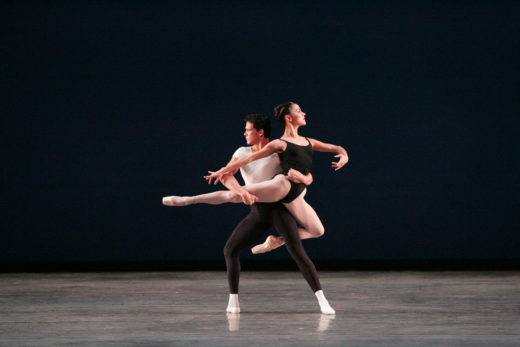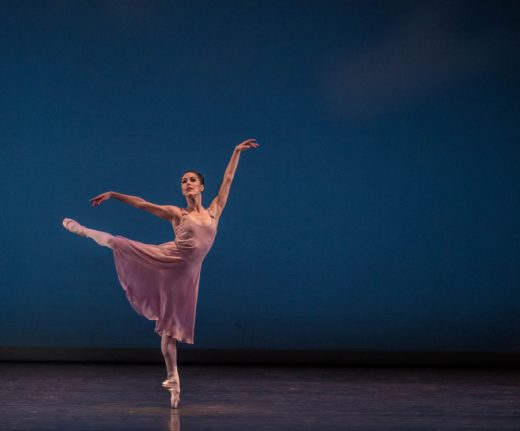- Islam & the Imagination: Notes from an American Artist in the 21st Century

- The Art of Protest: A review of Valeria Luiselli’s Tell Me How It Ends
360 Degrees of Light: Patricia Delgado’s Next Steps
Laila Pedro
 Patricia Delgado and former MCB dancer Carlos Guerra in The Four Temperaments. Choreography by George Balanchine © The George Balanchine Trust. Photo by Joe Gato.
Patricia Delgado and former MCB dancer Carlos Guerra in The Four Temperaments. Choreography by George Balanchine © The George Balanchine Trust. Photo by Joe Gato.
In New York or Paris or Saint Petersburg, these events are, if profoundly significant, certainly not infrequent. They are cities with august ballet traditions, boards of directors multiple generations deep, dancers who trained in the studio programs from childhood. Every couple of years an icon retires—Wendy Whelan, Julie Kent, Paloma Herrera, Xiomara Reyes—and each is duly showered with adoration and appreciation, and then the next season begins.
When Patricia Delgado danced her final performances with the Miami City Ballet (MCB) at the Broward Center of Performing Arts on April 8 and 9, she was not one among many; there was nothing routine about the moment. In many ways, all of the narratives and histories that in bigger, older cities are distributed among a phalanx of primas were here, nearly literally, contained in her tiny, powerful, fiery frame. Delgado embodies the heart’s blood of MCB; for nearly two decades, it has often felt as though she is, in large part, the institution. This spring, Delgado leaves the only dance family she has really known to join her partner, New York City Ballet (NYCB) Resident Choreographer Justin Peck, in New York.
A protégée of Edward Villella, the company’s founder and himself a protégé of NYCB founder George Balanchine, Delgado, under Linda Villella’s tutelage, carried on the legacy of Balanchine’s unmistakable technique—its ebullience and uncannily sensitive musicality; its dazzling speed and crystalline footwork—for Miami audiences. (“Our class is faster; even our adagio is faster!” she says.) In a city of Cuban exiles more accustomed to the emotive lyricism and sweeping épaulement of Russian ballet, or to the muscular expressivity embodied by Alicia Alonso, the lightness, joyfulness, and fresh modernism of Balanchine presented a sparkling contrast. The technique, Delgado observes, also offers freedom; she credits the multidirectional physical ambition of Balanchine training with giving her the ability and agility to expand and adapt as a dancer when the company added works by Robbins, Taylor, and Tharp to its originally more restricted, classical repertoire. Describing her sense of herself on the stage—the unmitigated lightness and joy that shine through in her dancing—Delgado recalls a breakthrough moment with Patrick Corbin: “Patrick always told us to feel the golden light 360 degrees. It’s not frontal. There’s an aura 360 degrees around you. And you need to think of yourself and not just the mirror of the audience—they morph into each other, back and forth, and enrich each other.”
This exuberance and freedom are part of what make Delgado’s dancing so breathtaking (other Balanchine dancers take it even further: NYCB’s Ashley Bouder is endearingly famous for frequently getting so excited she falls while performing, a consequence of the Balanchine technique’s pushing of classical lines so the weight goes far past and over the leg), but so is the emotional depth of dancing within a family. The notion of a dance company as a family is an old one, with varying configurations. Perhaps among the most intense iterations is the “family” formed in Pina Bausch’s company, Tanztheater Wuppertal, which extended to a second generation of children born and reared within the company.
For Delgado, the sense of family was not constructed: she danced not only with a company many of whose principals had been together for years, but also with her actual sister, Jeanette. And in a frequently punishing art field not known for tolerating any perceived imperfection, she inhabited a space that celebrated difference and growth. “It’s not a group of perfect everythings,” she says of MCB. “We’re grateful to be dancers and grateful for our [repertoire] that’s so diverse and so satisfying because it’s so hard. The gratefulness and generosity with each other is what we feel and what you see.”

Patricia Delgado in Dances at a Gathering. Choreography by Jerome Robbins. Photo © Daniel Azoulay.
If injuries or divergences from the impossible ideals of ballet have posed challenges, they also inflect her distinctive style: “I’m very Miami; we know how to maneuver our flaws. I think it’s a constant back and forth, a see-saw of how much you want to change, of how much you want to make better or create more organic movement, and how much you want to just accept. Not because you can’t change it, but maybe because someone will find it beautiful.”
And while the options available to ballerinas after leaving their companies used to be chillingly bleak, the past few years have brought welcome signs of evolution and possibility. Until recently there had been a clear trajectory, particularly for female dancers, of moving directly and exclusively into teaching or coaching. Delgado is curious and excited about what there is to be learned from teaching—how generosity can be shared, and how it can deepen her own understanding—but it’s not her only plan. With this generation of ballerinas, as the culture grows in some ways more flexible and more open, there is a calmer, more optimistic tone in contemplating next steps. More avenues for creative growth and exploration are manifesting even as dancers leave their longtime companies. (Wendy Whelan has continued to perform in solos and duets; last year, Julie Kent became Artistic Director of the Washington Ballet in D.C.). “I think we were lucky that in our generation there was less competition and more support amongst the company,” she says. “Those stories of the cutthroat, glass-in-the-pointe-shoe—for us it’s just myth at this point.” Delgado seems interested in all of it—delighted, really, with an infectious, omnivorous curiosity, to be for the first time in decades, unsure of what comes next.
For her final performances, Delgado danced Balanchine’s “Divertimento No. 15” and “Who Cares?”—the first piece she ever performed with MCB. Asked about the serendipitous symmetry, Delgado seems to embrace not only the moment itself, but what lies just beyond it: “There wasn’t a plan for this to happen. It feels like a perfect fit now. It feels very full-circle. Even the lyrics: ‘Who could ask for anything more?’ It’s a way to say ‘Thank you’ back.”
Laila Pedro is a Havana-born writer, scholar, and editor based in New York, where she is Managing Editor of the Brooklyn Rail. She is a lifelong student of classical ballet and holds a Ph.D. in French from the Graduate Center, City University of New York.









